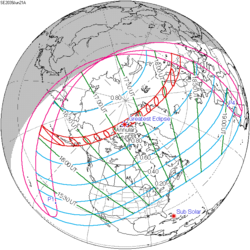| Total eclipse | |
| Gamma | −0.2881 |
|---|---|
| Magnitude | 1.0268 |
| Maximum eclipse | |
| Duration | 138 s (2 min 18 s) |
| Coordinates | 40°18′S164°00′E / 40.3°S 164°E |
| Max. width of band | 95 km (59 mi) |
| Times (UTC) | |
| Greatest eclipse | 1:00:10 |
| References | |
| Saros | 142 (24 of 72) |
| Catalog # (SE5000) | 9594 |
A total solar eclipse will occur at the Moon's descending node of orbit between Saturday, December 25 and Sunday, December 26, 2038, [1] with a magnitude of 1.0268. A solar eclipse occurs when the Moon passes between Earth and the Sun, thereby totally or partly obscuring the image of the Sun for a viewer on Earth. A total solar eclipse occurs when the Moon's apparent diameter is larger than the Sun's, blocking all direct sunlight, turning day into darkness. Totality occurs in a narrow path across Earth's surface, with the partial solar eclipse visible over a surrounding region thousands of kilometres wide. Occurring about 1.7 days after perigee (on December 24, 2038, at 8:25 UTC), the Moon's apparent diameter will be larger. [2]
Contents
- Images
- Eclipse timing
- Places experiencing total eclipse
- Places experiencing partial eclipse
- Eclipse details
- Eclipse season
- Related eclipses
- Eclipses in 2038
- Metonic
- Tzolkinex
- Half-Saros
- Tritos
- Solar Saros 142
- Inex
- Triad
- Solar eclipses of 2036–2039
- Saros 142
- Metonic series
- Tritos series
- Inex series
- Notes
- References
- External links
Totality will be visible from parts of Australia and New Zealand. A partial eclipse will be visible for parts of Southeast Asia, Australia, Antarctica, and Oceania.
In some parts of the world it will fall on Christmas Day, the first such eclipse since 2000, and the last until 2057. [3] : 137






































































































